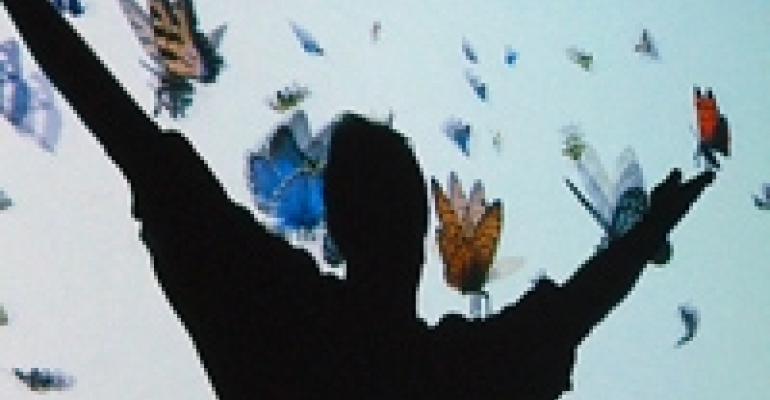THE TECH: VR-MAX
WWW.VR-MAX.COM

THE TALK: Back in 1997, when cleaning-product manufacturer Ecolab called on Craig Sinard to create an immersive event presentation that would reflect the company's world-leader position, immersive meant one-ton “coffins,” eight hours of setup and four hours of tear-down. These days, instead of cumbersome coffins, Sinard's VR-MAX executes Fulldomes, Curves, CAVEs and other immersive environments that use special lenses and proprietary software “to create a vertigo-inducing experience without making someone ill,” Sinard notes.
THE PROCESS: Collaboration is important to VR-MAX — but so is allowing the company team to do what it does best. As Sinard explains, “We're all trained from birth to ‘think flat’ — flat plasma screens, flat iPads, etc. — so it's hard to move into a world that works like your eyes, with 180 degrees of peripheral vision.” Some event clients get it, others don't. Sinard warns that “rock-video editing with lots of fast cuts” — sometimes requested by event producers — doesn't work for a “medium whose very effectiveness depends on the opposite.” But if you're willing to let VR-MAX do its thing, you'll have a fully immersive experience for your product, service or brand in about six weeks from script approval.
THE TIP: Nothing creates buzz at an event like a VR-MAX dome. After all, natural human curiosity being what it is, “You can't walk past a dome and not wonder, ‘What's in there?’” Sinard says. Plus, as an event planner, if you need to replicate the experience of a not-easily-visible environment such as outer space or the inner workings of a circuit board, you can't do better than an immersive dome, where the environment doesn't just confront but completely surrounds the event participant.
THE TECH: INTERCALL
WWW.INTERCALL.COM

THE TALK: InterCall's “persistent virtual environment” technology “allows event organizers to create branded and interactive environments to engage and connect with audiences globally 24/365,” explains director of product marketing Eric Vidal.
Until recently, a live event might generate a virtual event that would allow remote attendees access in real time and for a couple of months after the event. But a persistent virtual environment, in which attendees can easily access content, subject matter experts and peers anytime, anywhere, lets planners “move away from doing a ‘one-and-done’ event,” Vidal explains. “The planner puts all this work into planning and putting on the event, and then it's over. When you have an InterCall environment, the content can live on and attendees can continue the conversations.” Planners can also track analytics on attendee demographics, behavior and activities long after the initial event is over.
THE PROCESS: InterCall works with event and meeting planners to create a “hybrid solution” that links an in-person event to a persistent virtual environment using a six-step process that includes strategy planning, experience building, promotional activities, environment launch and post-launch analysis.
THE TIP: Planning a product showcase, user conference or recruiting event? Take a cue from companies like IBM, Novartis and Johnson & Johnson, and consider creating an InterCall environment. “Having a persistent environment for any of these [events] is powerful because you are now able to extend your reach to a global audience and reach more people, more often,” Vidal says.
THE TECH: KAON INTERACTIVE
WWW.KAON.COM

THE TALK: First launched in 1996 as a video game animation company, Kaon Interactive realized a need for virtual experiences among B2B companies that sell complex products. Kaon now creates multi-platform product-interaction experiences that don't just explain but show, with incredible realism, how products work and solve problems. Corporate clients include Fujitsu, Juniper Networks and Ciena, who have utilized Kaon v-OSK virtual kiosks at trade shows, product launch events and, in one case, a mobile-lab road show produced in an 18-wheeler.
THE PROCESS: Starting three to six weeks out, a planner can identify a set of products and solutions to highlight at an event. The Kaon project team will shoot high-resolution photos of the products, create 3D models, render them fully interactive, and accompany them with succinct, explanatory text.
The coolest part? When the event is over, the content is usable by the sales and marketing team at other events, as well as on iPads, laptops and the company's website. “Truly reusable and expandable, the application becomes a living expression of how customers and prospects interact with the company's products in many venues,” notes company CEO and president Gavin A. Finn.
THE TIP: Got a lot of complex, fragile and expensive new telecom, medical or industrial products to demo at your next event? “By going virtual, Kaon customers can showcase all of their products, realizing dramatic savings by eliminating the need to ship them to globally dispersed sales events,” Finn says. “Event professionals love the amazing graphical quality of the applications, and they are blown away by the interactivity — the fact that the customer can move products around, open compartments, change configurations, etc.” These capabilities don't just “create excitement and a sense of fun,” but they “convey key competitive position messaging” — and help close sales, he adds.





